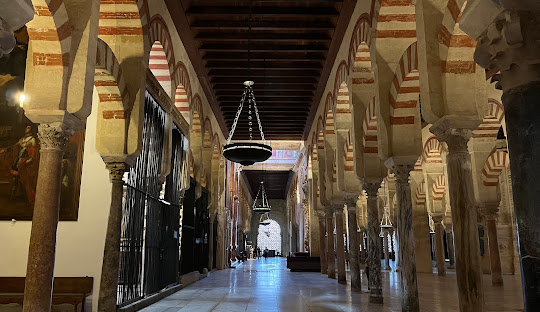Cordoba .Spain
Córdoba: A City of Timeless Heritage and Stunning Architecture
Nestled along the banks of the Guadalquivir River, Córdoba is a city steeped in history, offering a captivating blend of Moorish, Roman, and Christian influences. Famous for its Mezquita, one of Spain's most iconic landmarks, Córdoba invites you to step back in time and wander through its narrow streets, flower-filled patios, and grand palaces.
Whether you're admiring the intricate details of the Mezquita or exploring the charming Jewish Quarter, Córdoba offers a magical atmosphere filled with history, culture, and tradition.
📍 Top Things to Do in Córdoba
🕌 1. The Mezquita (Mosque-Cathedral)
-
Why Visit: A UNESCO World Heritage Site, the Mezquita is Córdoba's most famous landmark. This stunning mosque-turned-cathedral is renowned for its forest of arches, intricate carvings, and the contrast between Islamic and Christian architectural styles. It's one of the best-preserved monuments of Moorish architecture in Spain.
Pro Tip: Be sure to visit at different times of day to experience the changing light within the building, creating a mesmerizing atmosphere.
🏰 2. Alcázar de los Reyes Cristianos (Palace of the Christian Kings)
-
Why Go: This stunning fortress-palace, with its beautiful gardens and mosaic-tiled courtyards, was once the home of Ferdinand and Isabella, the Catholic Monarchs. It’s a wonderful place to explore both history and nature in one spot.
🏙️ 3. The Jewish Quarter (Judería)
-
Why Visit: Wandering through the narrow, winding streets of the Judería feels like stepping into another era. This historic Jewish quarter is home to the Córdoba Synagogue, the Calleja de las Flores, and countless patios adorned with flowers.
🌉 4. Roman Bridge and Calahorra Tower
-
Why Go: The Roman Bridge is one of the oldest structures in the city, offering stunning views of the Guadalquivir River and the Mezquita. At the far end, the Calahorra Tower houses a museum dedicated to Córdoba's history under Muslim rule.
🌸 5. Patio Festival
-
Why Experience: Every May, Córdoba’s Patios Festival showcases the city’s beautiful flower-filled courtyards. You can explore these private courtyards, filled with colorful plants, vibrant flowers, and historical architecture.
🍽️ Córdoba’s Gastronomic Delights
Córdoba is a culinary destination where the flavors of Andalusia come alive, featuring simple yet delicious dishes influenced by its multicultural past.
🍖 1. Salmorejo
-
A creamy, cold tomato soup topped with hard-boiled eggs and jamón serrano — a must-try during the hot summer months.
🧀 2. Flamenquín
-
A deep-fried roll of ham and pork, traditionally served with fries or a side salad.
🍞 3. Berenjenas con Miel (Eggplant with Honey)
-
Fried eggplant drizzled with honey for a sweet and savory dish that is a local favorite.
🍷 4. Local Wines and Sherry
-
Córdoba is known for its wines and is situated in the Montilla-Moriles wine region, famous for fortified sherry wines.
🏞️ Explore Córdoba’s Natural Beauty
Córdoba is surrounded by picturesque landscapes, offering opportunities for outdoor activities and day trips.
🌿 1. Medina Azahara
-
Just outside Córdoba, the Medina Azahara is a fascinating archaeological site of a Moorish palace city. It’s an ideal spot to explore for history lovers and those interested in the early Islamic period of Spain.
🏞️ 2. Sierra de Hornachuelos Natural Park
-
This nature reserve just outside the city is perfect for hiking and wildlife watching, with beautiful forests and mountain landscapes.
🏨 Where to Stay in Córdoba
Córdoba offers a range of accommodation options, from luxurious hotels to charming guesthouses.
| Type | Where | Why |
|---|---|---|
| Luxury | Balcon de Cordoba | Stay right next to the Mezquita with incredible views |
| Boutique | Hotel Casa de los Azulejos | A stylish boutique hotel in the Judería district |
| Budget | Hostel La Corredera | Affordable, comfortable, and centrally located |
🧳 How to Get to Córdoba
-
By Train: Córdoba is well-connected by Renfe trains to Madrid, Seville, and Malaga.
-
By Bus: The Córdoba bus station offers routes to other Andalusian cities.
-
By Air: Córdoba doesn’t have its own airport, but it’s easily accessible from Seville and Malaga airports.
🌞 When to Visit Córdoba
The best times to visit Córdoba are in spring (April to June) and fall (September to October) when the weather is pleasant and the city is not as crowded. Summers can be extremely hot, so plan accordingly.
💬 Final Thoughts on Córdoba
Córdoba is a city that blends the best of history, culture, and culinary traditions. From the awe-inspiring Mezquita to the charming Jewish Quarter and delicious local cuisine, it’s a destination that captures the essence of Andalusia.


